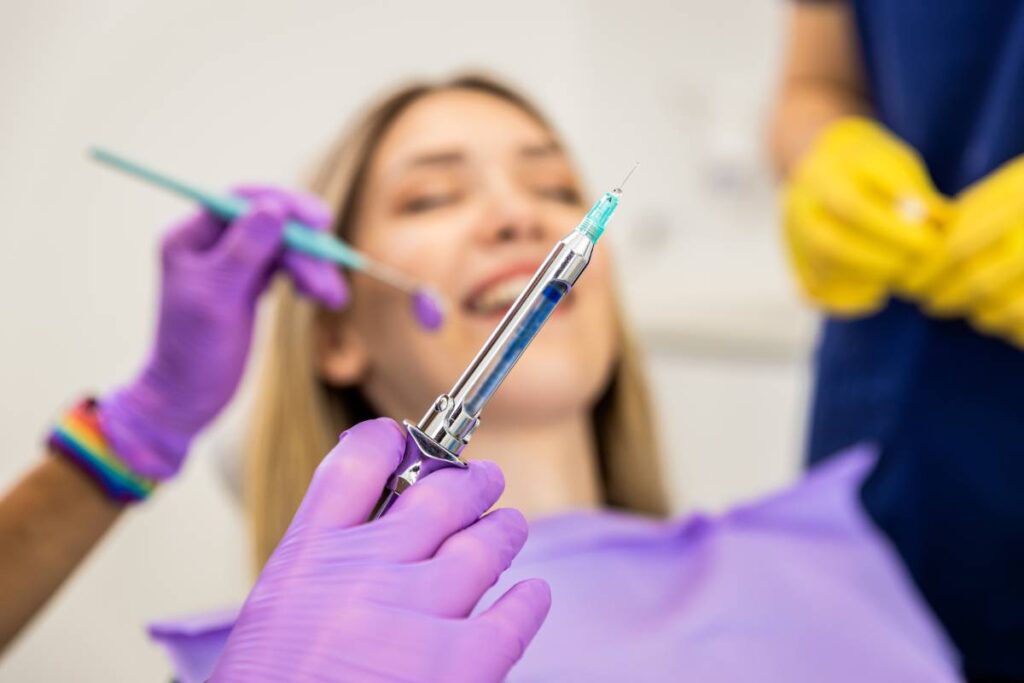Dental surgeries can include many different procedures, including tooth extractions, root canals, periodontal surgery, dental implants, and corrective jaw surgery. A key component in many of these treatments is the use of local anesthetics, which provides analgesia and numbing of the targeted area without affecting the patient’s consciousness. Understanding the mechanisms of action and effects of local anesthetics is vital for preventing perioperative complications, optimizing patient pain management, and ensuring safety and efficacy during dental surgery.
Injectable local anesthetics used in dental surgery typically have a common core structure of a hydrophilic amino terminal, an intermediate chain, and a lipophilic aromatic terminal.1 The hydrophilic portion of the molecule enables solubility in water, which is essential for the dissolution of the agent in a solvent for a dental cartridge injection, as well as the agent’s penetration through interstitial fluid after administration. The intermediate chain consists of either an amide or an ester linkage, which enables spatial separation for the hydrophilic and lipophilic tails. Lastly, the lipophilic terminal is an aromatic residue that plays a critical role in the anesthetic’s ability to penetrate fatty tissue (i.e., the lipid nerve sheath) to access the nerve cell membrane (i.e., the agent’s target site).2
A meta-analysis considered 30 peer-reviewed publications about dental surgery to assess the efficacy of various local anesthetics with different amide components. Thirteen in vivo studies and four review articles determined articaine provides superior efficacy compared to lidocaine, mepivacaine, prilocaine, and bupivacaine. In addition to successful anesthesia of the target region, factors such as lower pain (VAS) scores during the injection and treatment phases, shorter onset of pulpal anesthesia, and lower adverse events were also taken into the operational definition of efficacy. Separately, one review and one in vivo study found mepivacaine and bupivacaine were more efficacious than lidocaine. However, eleven studies found no significant difference between the types of amides used in local anesthesia.3
Just as articaine appears to be more effective than other commonly used local anesthetics, the amide’s neurotoxic properties also seem to be less profound than its counterparts. One in vitro study assessed the toxicity of six local anesthetic products on human neuroblastoma cells and found that articaine is the least toxic amide, whereas a separate in vitro study identified bupivacaine as the most toxic amide.4
A clinical study with 11 normotensive patients undergoing scheduled tooth extraction observed the cardiovascular and sympathetic responses of the patients following lidocaine anesthesia with epinephrine. Blood samples and cardiovascular measures such as heart rate and blood pressure were determined pre- and post-surgery for all patients. Both heart rate and blood pressure followed an expected course of spikes and recoveries during the perioperative process. Blood analysis illustrated serial changes in plasma catecholamines, serum glucose, and serum insulin concentrations, as elicited by local anesthesia and dental surgery.5 Plasma epinephrine and serum glucose levels both significantly increased immediately following anesthesia before returning to baseline levels. In contrast, plasma norepinephrine and serum insulin remained relatively constant from baseline to anesthesia administration to surgery to recovery. The results suggest that epinephrine in the injection may have entered systemic circulation, increasing plasma epinephrine levels. In addition, the time course of epinephrine and serum glucose were very similar, suggesting a close relationship between these variables. Indeed, hyperglycemia has been shown to be evoked by increasing plasma epinephrine concentrations.6 This effect is important in evaluating local anesthetics for patients with diabetes and other glucose sensitivities. Further studies may help elucidate the optimal anesthetic for diabetic patients seeking dental surgery.
Local anesthesia has an essential role in the success of various dental surgeries by allowing physicians to effectively manage pain while preserving patient awareness. The diverse array of local anesthetics used in dentistry offers unique advantages in terms of efficacy and safety. Despite some variability in the clinical results, literature to date has provided valuable insights into best practices for local anesthesia for dental surgery, which should be tailored toward individual patients.
References
- Haas, D.A., “An Update on Local Anesthetics in Dentistry.” Journal (Canadian Dental Association), 68(9), 2002, 546–51
- Bahl, R., “Local Anesthesia in Dentistry.” Anesthesia Progress, 51(4), 2004, 138–42, https://www.ncbi.nlm.nih.gov/pmc/articles/PMC2007495/
- Badr, N., and Aps, J., “Efficacy of Dental Local Anesthetics: A Review.” Journal of Dental Anesthesia and Pain Medicine, 18(6), 2018, 319, https://doi.org/10.17245/jdapm.2018.18.6.319
- Garisto, G.A., et. al. “Occurrence of Paresthesia after Dental Local Anesthetic Administration in the United States.” The Journal of the American Dental Association, 141(7), 2010, 836–44, https://doi.org/10.14219/jada.archive.2010.0281
- Nakamura, Y., et. al. “Cardiovascular and Sympathetic Responses to Dental Surgery with Local Anesthesia.” Hypertension Research, 24(3), 2001, 209–14, https://doi.org/10.1291/hypres.24.209
- Cherrington, A. D., et. al. “Effect of Epinephrine on Glycogenolysis and Gluconeogenesis in Conscious Overnight-Fasted Dogs.” American Journal of Physiology-Endocrinology and Metabolism, 247(2), 1984, 137–44, https://doi.org/10.1152/ajpendo.1984.247.2.E137



